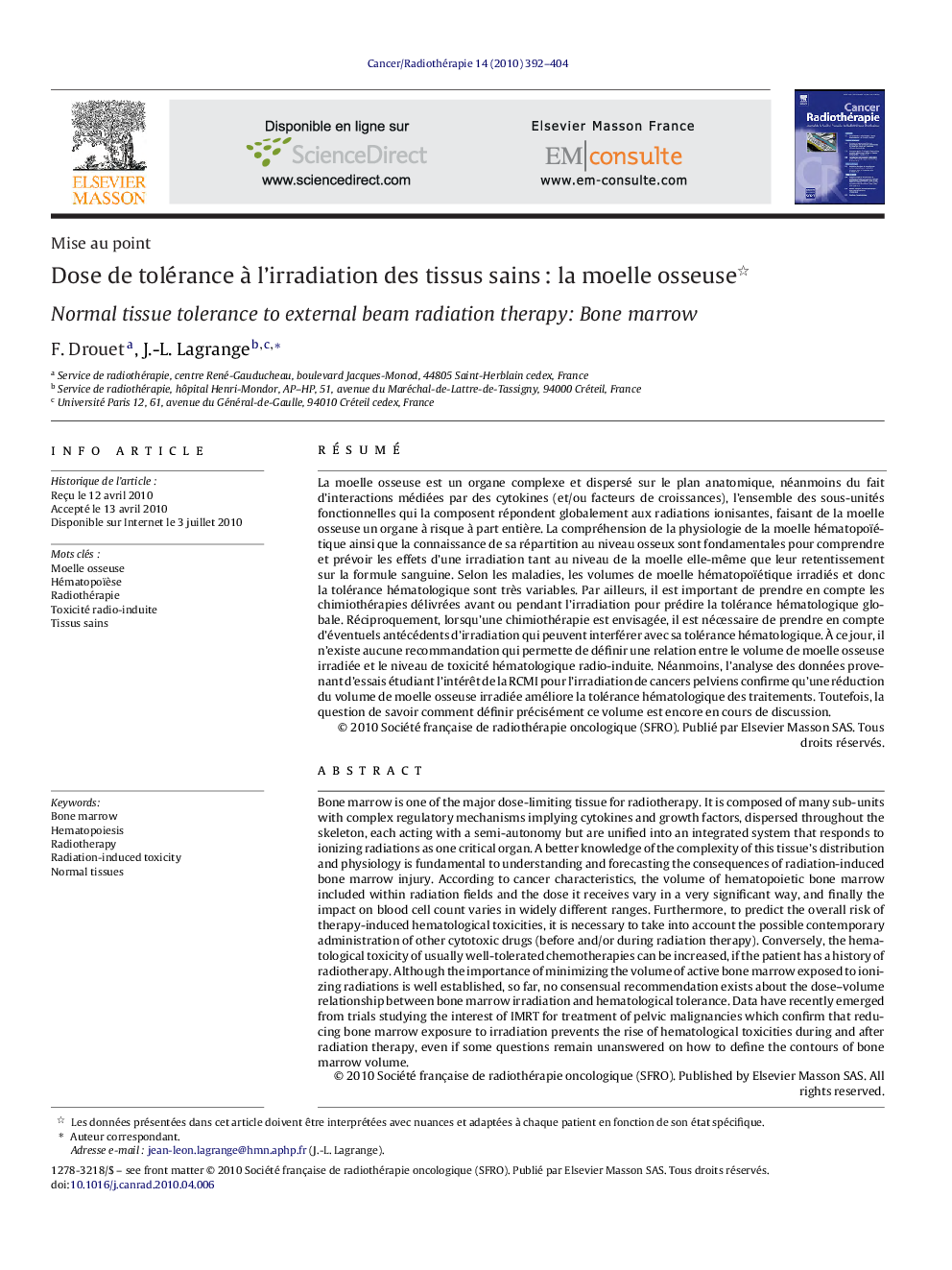| کد مقاله | کد نشریه | سال انتشار | مقاله انگلیسی | نسخه تمام متن |
|---|---|---|---|---|
| 2118904 | 1546739 | 2010 | 13 صفحه PDF | دانلود رایگان |

RésuméLa moelle osseuse est un organe complexe et dispersé sur le plan anatomique, néanmoins du fait d’interactions médiées par des cytokines (et/ou facteurs de croissances), l’ensemble des sous-unités fonctionnelles qui la composent répondent globalement aux radiations ionisantes, faisant de la moelle osseuse un organe à risque à part entière. La compréhension de la physiologie de la moelle hématopoïétique ainsi que la connaissance de sa répartition au niveau osseux sont fondamentales pour comprendre et prévoir les effets d’une irradiation tant au niveau de la moelle elle-même que leur retentissement sur la formule sanguine. Selon les maladies, les volumes de moelle hématopoïétique irradiés et donc la tolérance hématologique sont très variables. Par ailleurs, il est important de prendre en compte les chimiothérapies délivrées avant ou pendant l’irradiation pour prédire la tolérance hématologique globale. Réciproquement, lorsqu’une chimiothérapie est envisagée, il est nécessaire de prendre en compte d’éventuels antécédents d’irradiation qui peuvent interférer avec sa tolérance hématologique. À ce jour, il n’existe aucune recommandation qui permette de définir une relation entre le volume de moelle osseuse irradiée et le niveau de toxicité hématologique radio-induite. Néanmoins, l’analyse des données provenant d’essais étudiant l’intérêt de la RCMI pour l’irradiation de cancers pelviens confirme qu’une réduction du volume de moelle osseuse irradiée améliore la tolérance hématologique des traitements. Toutefois, la question de savoir comment définir précisément ce volume est encore en cours de discussion.
Bone marrow is one of the major dose-limiting tissue for radiotherapy. It is composed of many sub-units with complex regulatory mechanisms implying cytokines and growth factors, dispersed throughout the skeleton, each acting with a semi-autonomy but are unified into an integrated system that responds to ionizing radiations as one critical organ. A better knowledge of the complexity of this tissue's distribution and physiology is fundamental to understanding and forecasting the consequences of radiation-induced bone marrow injury. According to cancer characteristics, the volume of hematopoietic bone marrow included within radiation fields and the dose it receives vary in a very significant way, and finally the impact on blood cell count varies in widely different ranges. Furthermore, to predict the overall risk of therapy-induced hematological toxicities, it is necessary to take into account the possible contemporary administration of other cytotoxic drugs (before and/or during radiation therapy). Conversely, the hematological toxicity of usually well-tolerated chemotherapies can be increased, if the patient has a history of radiotherapy. Although the importance of minimizing the volume of active bone marrow exposed to ionizing radiations is well established, so far, no consensual recommendation exists about the dose–volume relationship between bone marrow irradiation and hematological tolerance. Data have recently emerged from trials studying the interest of IMRT for treatment of pelvic malignancies which confirm that reducing bone marrow exposure to irradiation prevents the rise of hematological toxicities during and after radiation therapy, even if some questions remain unanswered on how to define the contours of bone marrow volume.
Journal: Cancer/Radiothérapie - Volume 14, Issues 4–5, July 2010, Pages 392–404